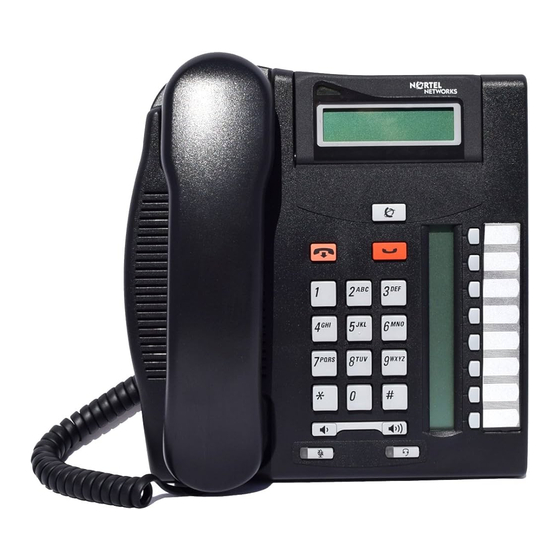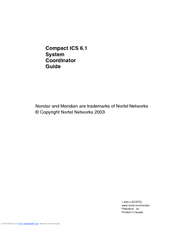
Nortel NORSTAR Modular ICS 6.1 Software Manuals
Manuals and User Guides for Nortel NORSTAR Modular ICS 6.1 Software. We have 2 Nortel NORSTAR Modular ICS 6.1 Software manuals available for free PDF download: Manual
Nortel NORSTAR Modular ICS 6.1 Manual (278 pages)
Compact System Coordinator Guide
Table of Contents
-
Line Buttons44
-
Making Calls73
-
Line Pools75
-
CCR Groups84
-
Using Speed Dial100
-
Saving a Number103
-
Using Hold105
-
Incoming Calls108
-
Outgoing Calls109
-
Using Camp-On114
-
Parking a Call115
-
Using Call Park116
-
Using Callback117
-
Forward on Busy121
-
DND on Busy121
-
Line Redirection123
-
Paging129
-
Using Voice Call136
-
Using Call Log139
-
Call Log Options140
-
Using Voice Mail145
-
User Preferences165
-
Setting the Name178
-
Feature Notes182
-
Desk Pswd185
-
Cond Pswd186
-
Call Restrns187
-
Using the Alarm192
-
Stopping Calls201
-
Isdn211
-
Isdn Bri211
-
Call Forward213
-
Automatic Recall214
-
MCID (Profile 2)214
-
File Transfer216
-
Telecommuting216
-
Group 4 Fax216
-
Using Passwords225
-
Direct-Dial228
-
Hotline229
-
SM Supervisor230
-
Using Set Lock231
-
Link233
-
Pause234
-
Long Tones234
-
Run/Stop235
-
Tones239
-
Hunt Groups243
-
Internal Numbers243
-
Line Assignment244
-
Target Line244
-
Line Pools245
-
Memory Buttons246
-
One-Line Display246
-
Prime Line247
-
Private Lines247
-
Volume Bar247
-
Troubleshooting249
-
Index257
Advertisement
Nortel NORSTAR Modular ICS 6.1 Manual (116 pages)
Table of Contents
-
-
-
Sysid21
-
Companion ID21
-
Registration23
-
Hardware
25-
Modules25
-
-
-
Line Access28
-
Capabilities29
-
Name30
-
Restrictions41
-
Set Restrns44
-
-
1Stdisplay45
-
Called ID45
-
Log Space45
-
-
-
Lines
46-
Name51
-
Restrictions52
-
Line Restrns52
-
-
Services
53-
-
Control Sets59
-
-
Passwords
61-
COS Pswds61
-
Hospitality62
-
SM Passwd62
-
-
Time&Date
63 -
-
Hunt Groups63
-
Change Dns63
-
Direct-Dial64
-
Dialing Plan65
-
Access Codes65
-
DN Length68
-
Make / Break68
-
Cbc Limits68
-
Hospitality69
-
SM Sets69
-
-
-
ONN Blocking70
-
Hardware
72 -
Maintenance
81-
Sys Test Log82
-
-
-
Access Codes89
-
Advertisement

